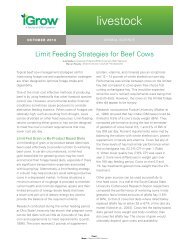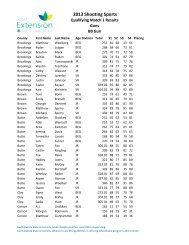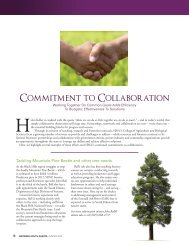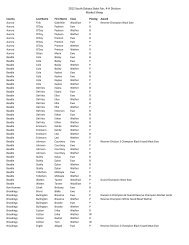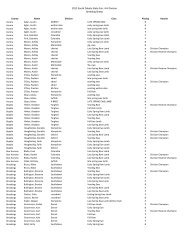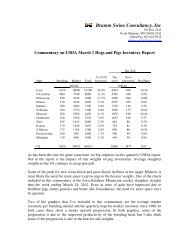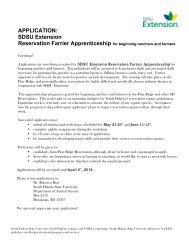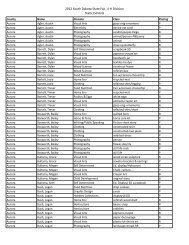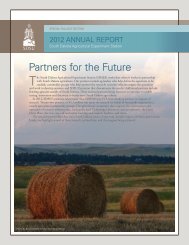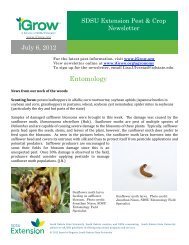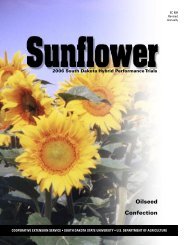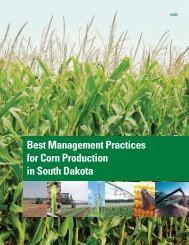Best Management Practices for Corn Production in South Dakota
Best Management Practices for Corn Production in South Dakota
Best Management Practices for Corn Production in South Dakota
You also want an ePaper? Increase the reach of your titles
YUMPU automatically turns print PDFs into web optimized ePapers that Google loves.
CHAPTER 8<br />
<strong>Corn</strong> Insect Pests<br />
Historically, the major corn <strong>in</strong>sect pests have been corn rootworms (northern and western), European<br />
corn borer, and black cutworm. Bt-corn hybrids are effective aga<strong>in</strong>st most of these pests. However,<br />
Bt-corn hybrids are not effective aga<strong>in</strong>st corn leaf aphid, corn root aphid, sap beetles, corn rootworm<br />
adults, grasshoppers, white grubs, wireworms, seed corn beetle, and seed corn maggots. These <strong>in</strong>sect<br />
pests can reduce corn yields. This chapter discusses the management and biology of important corn<br />
<strong>in</strong>sect pests commonly observed <strong>in</strong> <strong>South</strong> <strong>Dakota</strong>.<br />
<strong>Corn</strong> Rootworms (Diabrotica barberi and Diabrotica virgifera virgifera)<br />
Pest highlights<br />
ern<br />
corn rootworm and western corn rootworm.<br />
Bt-corn hybrids with the Bt-rootworm gene are<br />
effective aga<strong>in</strong>st corn rootworm larvae.<br />
<br />
corn rootworms.<br />
<br />
<strong>in</strong>sect pests of cont<strong>in</strong>uous corn <strong>in</strong> <strong>South</strong> <strong>Dakota</strong>.<br />
Rootworm description<br />
Adult northern corn rootworm beetles are approximately<br />
¼-<strong>in</strong>ch long and greenish to yellowish <strong>in</strong> color,<br />
while western corn rootworm beetles are yellow with<br />
black longitud<strong>in</strong>al mark<strong>in</strong>gs on their w<strong>in</strong>gs (fig. 8.1).<br />
Larvae of both species are white with a brown head and<br />
grow to a size of 5 /8 <strong>in</strong>ch (fig. 8.2). Both the larvae and<br />
the adults have chew<strong>in</strong>g mouthparts.<br />
Rootworm biology<br />
Rootworm larvae feed on corn roots and cannot<br />
normally survive on roots of other crops such as soybean,<br />
wheat, sunflower, and alfalfa. This feature makes<br />
crop rotation an excellent control approach. Because<br />
the most common alternative hosts <strong>for</strong> rootworm<br />
larvae are green, yellow, and giant foxtail, the control<br />
of these weed pests is important <strong>for</strong> limit<strong>in</strong>g future<br />
rootworm <strong>in</strong>festations.<br />
Rootworm eggs are laid <strong>in</strong> the soil from late summer<br />
until the female rootworm beetle adults are killed<br />
Figure 8.1. Adult beetles of northern corn rootworm<br />
(top) and western corn rootworm (bottom)<br />
(Photo courtesy of Mike Catangui, <strong>South</strong> <strong>Dakota</strong> State University)<br />
Figure 8.2. Larvae and pupae of corn rootworms<br />
(Photo courtesy of Mike Catangui, <strong>South</strong> <strong>Dakota</strong> State University)<br />
CHAPTER 8: <strong>Corn</strong> Insect Pests 49



